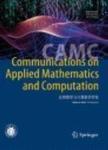Growth of RB Population in the Conversion Phase of Chlamydia Life Cycle
作者机构:Department of MathematicsUniversity of CaliforniaIrvineCA92697-3875USA
出 版 物:《Communications on Applied Mathematics and Computation》 (应用数学与计算数学学报(英文))
年 卷 期:2024年第6卷第1期
页 面:90-112页
核心收录:
学科分类:07[理学] 070202[理学-粒子物理与原子核物理] 0701[理学-数学] 0702[理学-物理学]
主 题:Chlamydia Life cycle Optimal control Maximal infectious spread Specie competitive survival
摘 要:Upon infecting a host cell,the reticulate body(RB)form of the Chlamydia bacteria simply proliferates by binary fission for an extended period.Available data show only RB units in the infected cells 20 hours post infection(hpi),spanning nearly half way through the development cycle.With data collected every 4 hpi,conversion to the elementary body(EB)form begins abruptly at a rapid rate sometime around 24 hpi.By modeling proliferation and conversion as simple birth and death processes,it has been shown that the optimal strategy for maximizing the total(mean)EB population at host cell lysis time is a bang-bang control qualitatively replicating the observed conversion activities.However,the simple birth and death model for the RB proliferation and conversion to EB deviates in a significant way from the available data on the evolution of the RB population after the onset of RB-to-EB conversion.By working with a more refined model that takes into account a small size threshold eligibility requirement for conversion noted in the available data,we succeed in removing the deficiency of the previous models on the evolution of the RB population without affecting the optimal bang-bang conversion strategy.



